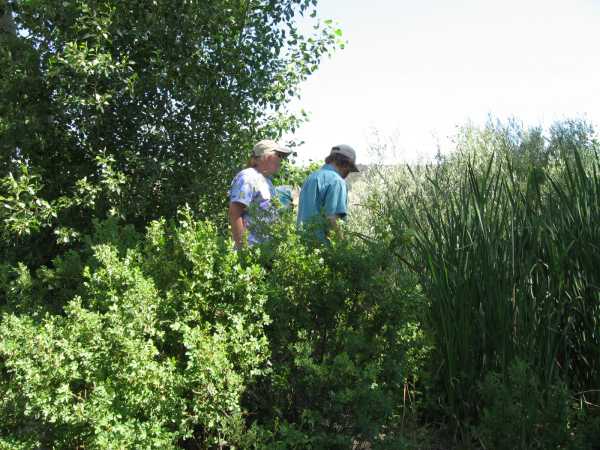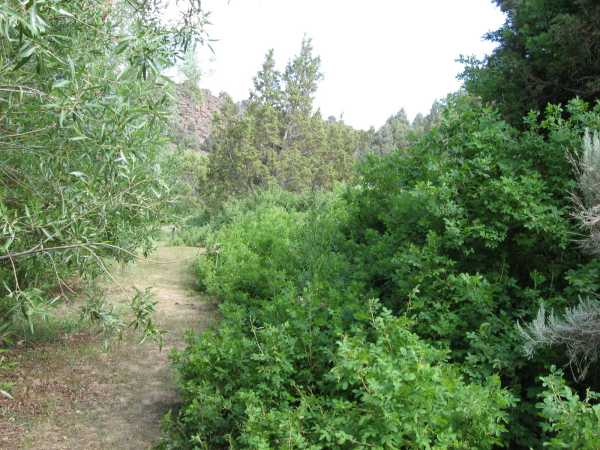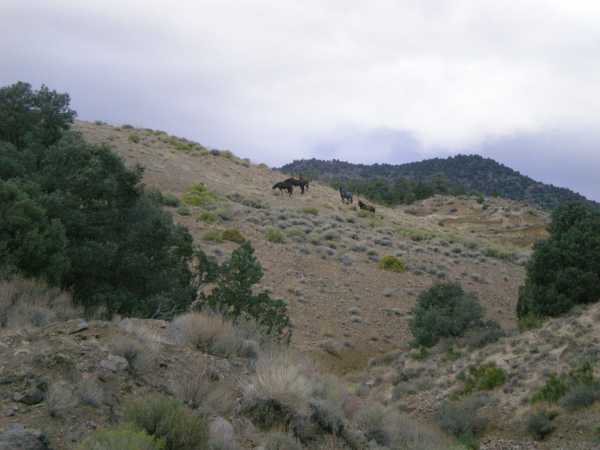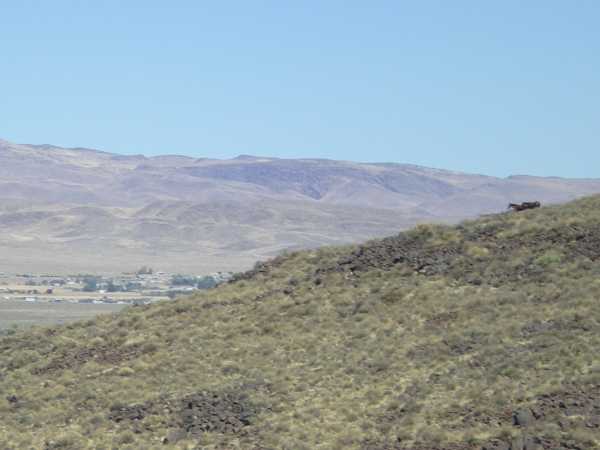|
Crooks and Liars
|
|
New Nevada Agriculture Director
Takes Aim at Wild Horses
Part Three
|
Exposing the Lies, Point by Point, Continued
The following statements were taken verbatim from the AP article.
"I am far more concerned about the decline of the Virginia Range as an environmentalist than I am concerned about those horses." he said Wednesday. "There is a total loss of Forage."
Horse advocates and outdoor enthusiasts who routinely explore the Virginia and Flowery Ranges are scratching their heads over this statement, and the common question is "What declined range is Lesperance talking about?" The only places that even came close to his description of a "total loss of forage" were burn-outs from wildfires and a couple of sections that were overgrazed by cattle.
Volunteers checking Cottonwood Springs, frequented by horses, photographed in mid-summer.

Typical mid-summer vegetation at the north end of the range.

Horses in Six Mile Canyon, photographed in late fall.

And Lesperance is concerned about the range as an environmentalist? What a lie! On March 3, 2008, the Las Vegas Review-Journal published an article about the man Mother Jones described as "one of the most radical members of a movement that energized rural anti-government crusaders." The article is worth reading and the prediction made by an Elko County resident in the comments section has certainly come true.
Agriculture director in Shovel Brigade .
Back to the A.P. Article -
Assemblyman Tom Grady, R-Yerington, said he has been getting calls from people concerned about "starving" horses.
"There are over 1,200 horses up there now and no feed for them, "Grady said. "Where are you going to find the money to buy hay for them?"
Clearly the good Assemblyman, a banker, not any kind of range expert, needs to actually see the range for himself, talk to the Estray Manager and learn some facts, and know what resources are actually staged for deployment in his own district before he opens his mouth to the press. We did contact Assemblyman Grady who declined our offer to explain his position in this web report. (Update: Later in the Legislative Session, Assemblyman Grady turned out to be instrumental in trying to generate some practical positive changes in the horse program.)
For the record, there are a few disgruntled residents who like to illegally feed the Virginia Range horses. Illegal feeding causes a whole host of problems. Feeding attracts horses into developed areas and onto highways. Illegal feeding also contributes to a bit of nearby overgrazing as the horses are conditioned to linger close to available hand-outs rather than disburse to eat other available range forage. Typically when volunteers see overgrazed pockets in an otherwise healthy range and there isn't a concentration of cattle consuming the forage, there is usually some kind of illegal horse feeding activity taking place nearby.
For a greater explanation regarding the illegal feeding of wild horses, please see
Local "Do_Gooders" Spoil Wild Bands and "Good Intentions" Killing Wild Horses.
"It's a serious, serious problem. It's going to be dealt with," Lesperance said. "We are going to bring the number of horses down as rapidly as we can."
The "serious, serious problem" actually involves department heads who earn salaries supplied by us taxpayers and who use their government positions to advance agendas that waste tax money and do little, if anything, to advance the mission of the department.
Here's the true "serious, serious problem."
The State of Nevada is experiencing a real financial crisis. Programs and services are being cut back all across the state. Some of these programs are significant to the people who rely on them. Yet Governor Gibbons' appointee wants to manufacture a crisis, abandon low cost management options before the results of those efforts can be evaluated, and commit to an open-ended financial obligation to construct new holding corrals, bring in large numbers of horses, and then make the state (and we taxpayers) responsible for feed, vaccinations, veterinary care and other related expenses. Even Forrest Gump could figure out that this math doesn't work. Why is it that essential state services can be squeezed while the Governor finds money to aid a few outlaw sagebrush rebel buddies?
He gave no indication on what plan for managing the horses he is considering, although he did say that there is little public demand for adopting the horses.
We have little doubt that Director Lesperance has presented no plan for managing the horses, however his statement about little public demand for adopting the horses is not supported by the facts.
First off, the state horses are held at the Northern Nevada Correctional Center next to the Stewart Indian Colony. This is a prison and the public can't simply drive out to view the horses as they can at a BLM facility. The Department, therefore, has two practical options with respect to getting horses placed - the inmate training program at Warm Springs Correctional Center and qualified non-profit groups that enter into cooperative agreements with the Department to hold and place horses for adoption.
Since Hank Curry has managed the Inmate Training Program, every horse offered through the program has been placed with adopters. Public records will validate this statement.
The adoption cooperators are just digging out from a colossal nightmare created by the Department wherein the Nevada Department of Agriculture precipitated the largest case of horse neglect in modern Nevada history and the largest case of horse neglect in modern California history. In actuality, it was the Department, through its inept actions, that caused the starvation of hundreds of horses, not overpopulation or mother nature.
Here's what happened.
In 2002 the Department aerial gathered horses just over the county line in Lyon County.
Citation:
Helicopter round up proceeds, Nevada Appeal, July 6, 2002.
The Nevada Department of Agriculture took custody of the aerial gathered horses along with others that were captured in bait traps. Then the Department
precipitated what was perhaps the most serious modern incident of horse abuse in the United States. Under published procedures the Department was supposed to
place gathered horses in adoptions through its network of non-profit cooperators. (Citation: State of Nevada Virginia Range Estray Horse Management Program Procedures.) Volunteer Shirley Allen had received commitments for groups to take at least 40
of the gathered horses when the Department violated its own procedures and administratively decided to give the horses to a California man named Slick Gardner.
The Department's public explanation was that the horses would be placed on Gardner's property into what the Department described was a "sanctuary" in Santa
Barbara County.
Citation:
Horses being rounded up by the state, Nevada Appeal, August 14, 2002.
Volunteers had done on-line research on Mr. Gardner and pointed out the risks to then acting director Don Henderson. Henderson dismissed those concerns. The so-called sanctuary turned out to be a nightmare where hundreds of horses were found in various states of starvation and untold numbers had died. Gardner
was later convicted on several counts including felony animal cruelty and grand theft. The horses were turned over to the Ojai non-profit group, Wild Horses in
Need.
Citation:
Gardner gets year in jail; plans appeal, Santa Maria Times, October 14, 2004.
Concurrently, back in 2003, on the recommendation of the Department, Gardner received several hundred Shoshone Indian horses, then later abandoned over 150 of those horses in rural Eureka County. Again the wild horse groups stepped in and took custody of the animals. The event became newsworthy when the carcasses of 48 dead horses from this lot were discovered dumped on nearby BLM land.
Citation:
Officials ponder charges over dead horses, Elko Daily Free Press, July 18, 2003.
The condition of still surviving horses when the wild horse groups stepped in.

View the web story on the Fish Creek horse recovery.
It should be noted that while this incident was likely the most significant case of horse abuse in the Nevada's modern history, officials in Nevada declined to
prosecute Mr. Gardner.
By this time the non-profit horse groups were inundated with hundreds of Nevada horses, many of them in extremely poor condition and requiring rehabilitation.
The aggregate costs to the groups approached a half million dollars. These were costs incurred to a great degree because the Nevada Department of Agriculture
failed to follow its own procedures and failed to conduct the most basic background checks on a private individual to which they turned over large numbers of
horses.
The ability for the cooperating adoption groups to take and place Virginia Range horses was severely hampered by the costs and logistics involved with the Slick
Gardner rescues. The Department continued to gather horses and they began to accumulate in the state holding corrals. Director of Agriculture Don Henderson
published a hands-wringing account of the problems caused by the backlog of unadopted horses and tested the notion of selling the horses outright. The concept
was met with the usual resounding negative feedback.
More recently, On April 5th, 2008 the adoption groups held an impromptu horse adoption at S&W Feed and Supply in Carson City to test this year's adoption "market." Over a quarter of the animals displayed were adopted. Given the current economy and the fact that this year's hay crop hasn't been cut and priced, this adoption did not produce a bad result.
In summation, Director Lesperance either doesn't know what he's talking about, which leads many to question why he was appointed to head a statewide department, or he is simply lying about the situation on the Virginia Range to benefit special interests, which leads others to question whether the public officials in the Gibbons Administration believe that they work for us citizens or that we citizens are be merely subjects of the state. In either event, too many people have documented the conditions of the range and the Virginia Range herd for Director Lesperance's false statements to gain any real traction. So the final question is, when will the Department abandon its manufactured crisis and the potentially significant taxpayer costs associated with it, and return its focus to low cost and efficient herd management options that the general public can support? Considering the current administration, such a result will probably occur only after a lot of time and taxpayer money is wasted on a scheme that the public simply won't accept.

The spirit of Thomas Paine lives

| 





